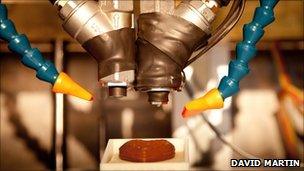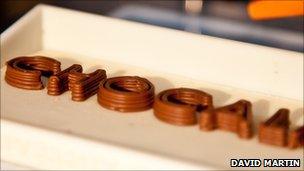Printer produces personalised 3D chocolate
- Published

The printer uses chocolate instead of ink
Chocolate lovers may soon be able to print their own 3D creations thanks to work by UK scientists.
A 3D printer that uses chocolate has been developed by University of Exeter researchers - and it prints layers of chocolate instead of ink or plastic.
Although still a prototype, several retailers have already expressed interest in taking on the device.
3D printing using plastic and metal is already widely used in industry to speed up design work.
Lead scientist Dr Liang Hao told BBC News that chocolate printing, just like any other 3D printing technique, starts with a flat cross-section image - similar to that produced by ordinary printers turning out images.
"Then you do a 3D shape - layer by layer, printing chocolate instead of ink, like if you were layering 2D paper to form a 3D shape," he said.
Once a layer is completed, it solidifies, and the machine moves on to the next layer.
Shape and taste
There have been other attempts to develop so-called "food printers" - in 2010, researchers from Cornell University in the US used liquefied foods as inks in a specially designed machine.
Dr Richard Hague from Loughborough University told BBC News that the Exeter creation is a step towards manufacturing a device able to print flawless 3D objects that taste good.

The machine builds up objects layer by layer
Getting the printing process right involves careful control of key parameters, such as temperature.
Once the prototype becomes a finished product, it may find a role in the restaurant and food preparation industry.
And some companies are already expressing interest.
"Obviously, it's chocolate, so it is hugely appealing," said Joanna Grant from UK online gift retailer findmeagift.co.uk.
But what is even more appealing, she added, is that customers will be able to design any object on a computer before hitting the print button.
"We could do things like 3D faces, for instance - the possibilities are enormous on a commercial aspect."
Social networks
Besides producing 3D chocolate, Dr Hao's team wants to go a step further - and take their printer into cyberspace.
He said the next step would be creating a chocolate-oriented website.
"Now we have an opportunity to combine chocolate with digital technology, including the design, digital manufacturing and social networking.
"Chocolate has a lot of social purpose, so our intention is to develop a community and share the designs, ideas and experience about it."
- Published21 February 2011
- Published24 December 2010